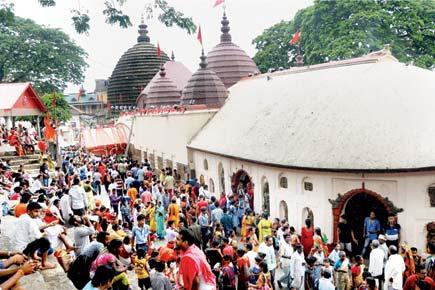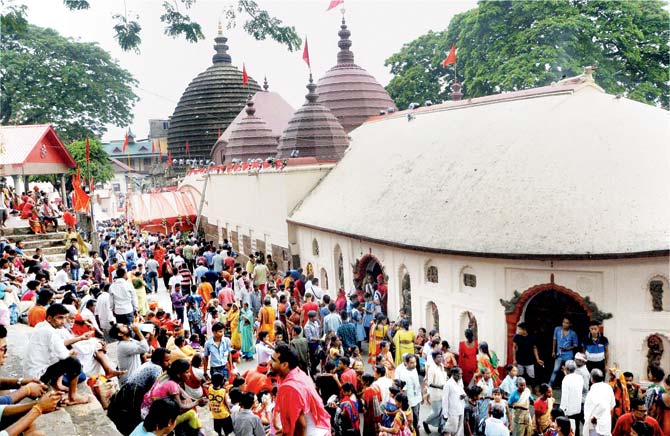The Kamakhya temple is one of the few places in misogynistic India where women and menstruation are not shunned but celebrated

 During the annual Ambubachi mela, the Kamakhya temple in Guwahati, Assam, closes its doors for three days, in celebration of Goddess Kamakhya’s menstruation. Imagine that. In a nation where actor Salman Khan likens his job to a woman getting raped (as if he, or I, could ever know what that is like, in all its dimensions), or a nation where temples do not allow women if they’re at that time of their cycle — there is a land where shakti worship means recognising the fact that a woman, a goddess even, has a monthly biological event interlinked with fertility (the mela happens around summer solistice, near the onset of the Southwest monsoon). Pilgrims throng to this historic temple during her periods — it’s a sort of Northeast kumbh. No wonder then, that in Guwahati women walk fearlessly, their body language reflecting a confidence that only adds to their already brimming beauty. Why can’t the rest of India learn from this paradise?
During the annual Ambubachi mela, the Kamakhya temple in Guwahati, Assam, closes its doors for three days, in celebration of Goddess Kamakhya’s menstruation. Imagine that. In a nation where actor Salman Khan likens his job to a woman getting raped (as if he, or I, could ever know what that is like, in all its dimensions), or a nation where temples do not allow women if they’re at that time of their cycle — there is a land where shakti worship means recognising the fact that a woman, a goddess even, has a monthly biological event interlinked with fertility (the mela happens around summer solistice, near the onset of the Southwest monsoon). Pilgrims throng to this historic temple during her periods — it’s a sort of Northeast kumbh. No wonder then, that in Guwahati women walk fearlessly, their body language reflecting a confidence that only adds to their already brimming beauty. Why can’t the rest of India learn from this paradise?

Thousands of devotees gather at Kamakhya temple in Guwahati during the Ambubachi mela last week. Pic/PTI
On a visit to my in-laws, I attended the Mela. My younger daughter Anya, who soon begins higher studies and who, to my lasting pride, calmly but swiftly takes down cousins who mindlessly spout North Indian machismo, also wanted to go. However, the rest of the family behaved as if Anya and I were going to enter a 1960s film in which twin babies get separated at a mela. “Don’t lose Anya,” my elder daughter Mrinalini commanded me. I promised to give Anya, who is nearly 18 and has an iPhone, a locket for identification so that we could be dramatically reunited if she got lost. In the end, however, Anya stayed home.
Kamakhya temple’s backstory is this: Lord Shiva’s better half, Goddess Parvati (aka Sati) immolates herself after her father, King Daksh, deliberately tries to humiliate her husband (Though Lord Shiva somehow seems un-humiliate-able). Shiva was enraged. He danced with his wife’s corpse, and that put the fear of God into the rest of the divine pantheon, since such dances usually ended with cosmic destruction and no one wanted space-time to end ahead of schedule. Lord Vishnu therefore, using his Sudarshan Chakra, cuts Parvati’s corpse to pieces, each of which falls in a different part of India (each landing in what eventually becomes a pitha-sthan); Parvati’s yoni (her genitalia) lands here, in Guwahati, on the Nilachal hill (562 feet above sea level). On that spot the Kamakhya temple is constructed, her yoni represented not by an idol but by a rock formation. (The temple complex has temples for all ten Mahavidyas — the ten aspects of Goddess Parvati.) Coming from a suffocatingly ‘traditional’ Bihari family, I find the way that this story consecrates the female yoni, without embarrassment, refreshing.
Throngs of us devotees, from all walks of life, climbed the hill on a nearly 4-km road, our sea of humanity occasionally parting to allow the well-connected in their private cars to pass (the road has been closed for the mela, and overstuffed buses have been organised for pilgrims). The not-walkers know not what they miss. All sorts of middle-aged, middle-class goddesses trudge with me, though their incessant spitting is less than divine. And an hour later, we circumambulate the temple — closed for the periods — meeting shakti devotees from around the country, tantrics, third gender devotees (born a god, became a goddess), groups of women immersed in kirtan, women sitting cross-legged outside the temple-walls deep in communion with the Mother Goddess, families taking a dip in the tank at the back, a matted-hair sadhu occasionally coming into view. Despite the crowd and the noise, there is a spiritual peace to be had here, as if the Mother Goddess takes hold of your mind and lifts it above the concrete matter of the senses. And looking at the gathered hijras in crimson saris, you can only feel that sexuality here is not something to be uptight about, that there is a harmony in this milieu.
The mela is a big deal, considering the kind of misogyny that casually informs the psychic and emotional landscape in mainstream India. It’s no coincidence that of the three Khans, Salman’s filmic image is that of a fiercely conservative male (as is his average fan), while Shah Rukh’s is playful like Lord Krishna and Aamir’s is that of the socially-concerned activist. India remains a society where giving birth to a girl is a curse, if she hasn’t been dragged out and murdered while in the womb. It’s a society where gang rape regularly makes the news pages. According to the 2011 census, the gender ratio at birth is 834 girls per 1,000 boys in Haryana, where I live; in Assam it is 962 girls (Kerala is best at 1,084 baby girls; the national average is 919). Clearly, it’s high time that mainstream India bowed its puny pinheads before the Mother Goddess.
Senior journalist Aditya Sinha is a contributor to the recently published anthology House Spirit: Drinking in India. He tweets @autumnshade. Send your feedback to mailbag@mid-day.com
 Subscribe today by clicking the link and stay updated with the latest news!" Click here!
Subscribe today by clicking the link and stay updated with the latest news!" Click here!









